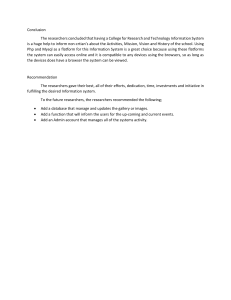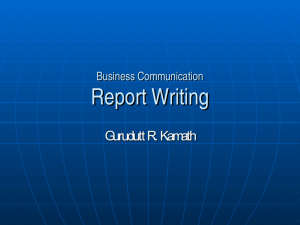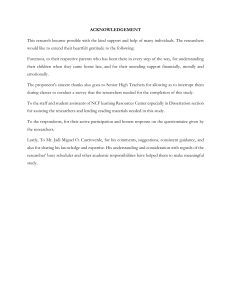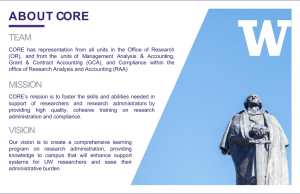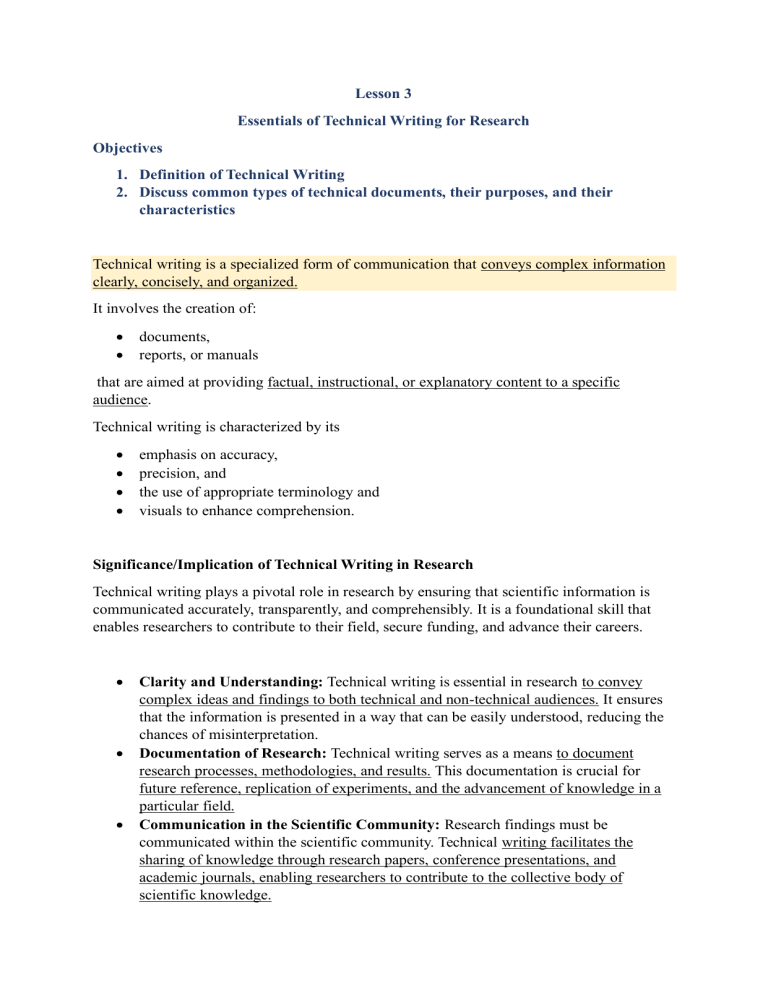
Lesson 3 Essentials of Technical Writing for Research Objectives 1. Definition of Technical Writing 2. Discuss common types of technical documents, their purposes, and their characteristics Technical writing is a specialized form of communication that conveys complex information clearly, concisely, and organized. It involves the creation of: • • documents, reports, or manuals that are aimed at providing factual, instructional, or explanatory content to a specific audience. Technical writing is characterized by its • • • • emphasis on accuracy, precision, and the use of appropriate terminology and visuals to enhance comprehension. Significance/Implication of Technical Writing in Research Technical writing plays a pivotal role in research by ensuring that scientific information is communicated accurately, transparently, and comprehensibly. It is a foundational skill that enables researchers to contribute to their field, secure funding, and advance their careers. • • • Clarity and Understanding: Technical writing is essential in research to convey complex ideas and findings to both technical and non-technical audiences. It ensures that the information is presented in a way that can be easily understood, reducing the chances of misinterpretation. Documentation of Research: Technical writing serves as a means to document research processes, methodologies, and results. This documentation is crucial for future reference, replication of experiments, and the advancement of knowledge in a particular field. Communication in the Scientific Community: Research findings must be communicated within the scientific community. Technical writing facilitates the sharing of knowledge through research papers, conference presentations, and academic journals, enabling researchers to contribute to the collective body of scientific knowledge. • • • Transparency and Reproducibility: Properly written technical documents provide a transparent account of research, including data collection, analysis, and conclusions. This transparency is vital for the peer review process and the ability of other researchers to replicate and validate the results. Grant Proposals and Funding: Technical writing is crucial for securing research funding. Well-written research proposals and grant applications are more likely to attract funding, enabling researchers to conduct their studies effectively. Professional Development: Proficiency in technical writing is a valuable skill for researchers. It enhances one's ability to communicate effectively, publish research, collaborate with peers, and advance in an academic or professional career. Let's discuss common types of technical documents, their purposes, and their characteristics: 1. Research Papers Purpose: Research papers are primary documents that present the results of original research. They aim to • • • contribute new knowledge, address research questions or hypotheses, and provide evidence to support their findings. Research papers are commonly published in academic journals or presented at conferences to share insights with the scientific community. Characteristics of a research paper: • • • • • • • Employs a formal and structured writing style, often following the IMRaD (Introduction, Methodology, Results, and Discussion) format. Contains a clear thesis statement or research question. Provides a comprehensive literature review to establish the context. Includes detailed methodology for data collection and analysis. Presents empirical results and statistical analysis. Offers a discussion of the findings, implications, and future research directions. Cites sources using a specific citation style (e.g., APA, MLA, Chicago). It is worth mentioning that there are reference management tools like EndNote and Zotero for managing references. 2. Technical Reports Technical reports are detailed documents created to communicate the results of research, experiments, or investigations conducted within organizations, government agencies, or industries. They often serve as internal documents, informing stakeholders about technical aspects, project progress, or recommendations. Characteristics • • • • • • Typically written in a more technical and specialized language. Contains a title, abstract, introduction, methodology, results, and conclusions. May include appendices with supplementary data, charts, or technical specifications. Focuses on providing a comprehensive account of the research process and outcomes. May include recommendations or action plans based on the findings. Often follows a specific report structure prescribed by the organization. 3. Manuals Manuals are instructional documents designed to guide users on how to use or operate a product, system, software, or equipment. They aim to provide step-by-step instructions, troubleshooting guidance, and reference information for users. Characteristics • • • • • • • Clear and concise language with a focus on usability. Organized into sections or chapters for easy navigation. Contains detailed explanations, diagrams, and illustrations. Includes safety instructions and warnings where applicable. May have a table of contents and an index for quick reference. Often written in a user-centric and task-oriented manner. Updated regularly to reflect changes or improvements. 4. Proposals Proposals are documents created to persuade and inform stakeholders about a proposed project, initiative, or idea. They seek approval, funding, or support for the proposed action. Characteristics • • • • • • • Begins with an executive summary summarizing the proposal's key points. Clearly defines the problem or opportunity the proposal addresses. Provides a detailed plan, including objectives, timeline, budget, and resources required. Addresses potential risks and mitigation strategies. Demonstrates the potential benefits or outcomes of the proposed action. Often includes visuals like charts or graphs to illustrate key points. Tailored to the needs and interests of the target audience. Each of these types of technical documents serves a distinct purpose, and their characteristics are tailored to meet those objectives. Effective technical writing involves understanding the unique requirements of each document type and skilfully crafting content to fulfil its intended purpose.

